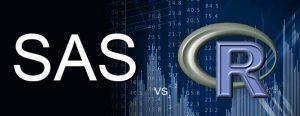
Cost Effectiveness
SAS is a commercial analytics software whereas R is open source hence, it is more accessible to new users. On the other hand, SAS is expensive licensed software but has an excellent support especially in critical areas and delicate scenarios where there is no room for experimentation, SAS has proven itself to be indispensable.
Ease of Learning
SAS is easy to learn and provides easy option (PROC SQL) for people who already know SQL. Even otherwise, it has a good stable GUI interface in its repository. In terms of resources, there are tutorials available on websites of various university and SAS has a comprehensive documentation. There are certifications from SAS training institutes, but they again come at a cost.
R has a steep learning curve. It requires you to learn and understand coding. R is a low level programming language and hence simple procedures can take longer codes.
Data Handling Capabilities
When it comes to data handling and management on standalone systems, SAS is safe, smooth and better. R computes every thing in memory (RAM) and hence the computations were limited by the amount of RAM on 32 bit machines. This is no longer the case. Both these languages have good data handling capabilities and options for parallel computations. This I feel is no longer a big differentiation. Also, I might not be aware of the latest innovation in each ecosystem.
Statistical Abilities
While SAS, R and Python come to the same footage when it comes to the standard statistical and modeling capabilities, in today’s world where we talk about advanced algorithms like machine-learning, and more nuanced options, R and Python outpace SAS hands-down.
Considering that R was designed to make statistician’s lives easy, it does have some field specific advantages with more than 7500 contributed packages and the list keeps growing on a daily basis. This is done through CRAN – Comprehensive R Archive Network. Owing to this ever active and enterprising community of R, number of the most recent techniques and experimental programs are available in R but not in SAS.
Graphical Capabilities
SAS has decent functional graphical capabilities. However, it is just functional. Any customization on plots are difficult and requires you to understand intricacies of SAS Graph package.
R has the most advanced graphical capabilities among the three. There are numerous packages which provide you advanced graphical capabilities.
Advancements in Tool
Both ecosystems have all the basic and most needed functions available. This feature only matters if you are working on latest technologies and algorithms.
Due to their open nature, R get latest features quickly. SAS, on the other hand updates its capabilities in new version roll-outs. Since R has been used widely in academics in past, development of new techniques is fast.
Having said this, SAS releases updates in controlled environment, hence they are well tested. R on the other hand, have open contribution and there are chances of errors in latest developments.
Conclusion
For analytics aspirants, it has become very important to add at least one open-source skill along with SAS in their quiver. In last one year, we have particularly seen candidates with R skills along with SAS knowledge gaining an upper hand in job opportunities and also command better salaries targeting wider variety of jobs.